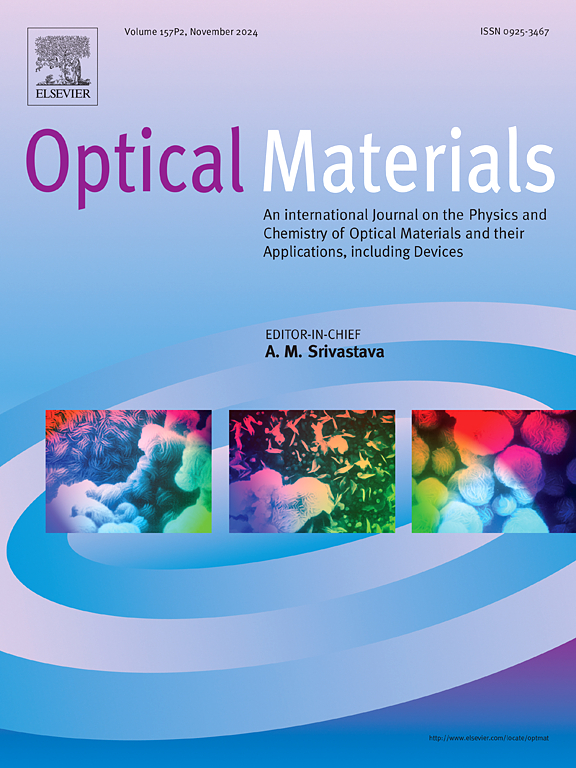Investigation of new potential erbium/promethium Co-doped aluminum tellurite glass in active optical materials
IF 3.8
3区 材料科学
Q2 MATERIALS SCIENCE, MULTIDISCIPLINARY
引用次数: 0
Abstract
The possibility of using trivalent erbium/promethium as the active ion in tellurite glass was achieved. Tellurite glass doped with ZnO–Al2O3–Pm2O3–Er2O3 synthesized by the melt-quenching technique. Glasses with varying Er2O3 doped concentrations have been produced in the temperature range of 900 °C. The glassy nature of the synthesized samples is verified by the X-ray diffraction (XRD) pattern. Furthermore, to study the synthesized glasses' spectroscopic properties, the absorption spectra are recorded in the range of 200 nm–1800 nm. The spectroscopic properties of the Er3+/Pm3+ co-doped ions were measured by the Judd-Ofelt theory. The maximum calculated values of Ωλ (λ = 2,4,6) are 6.5712, 2.29534 and 2.91274 for TZEAP2 glasses. The highest value of spectroscopic quality factor 1.3921 is obtained for the sample TZEAP1. The Judd Ofelt parameter for all the prepared glass samples are follows the trends Ω2>Ω4< Ω6. Three emission bands were detected in the visible region for the Er3+/Pm3+ ions doped to tellurite glass under the excitation of at 375 nm. These bands were at approximately around 470 nm, 500 nm and 550 nm from 2F5/2 → 4I15/2, 2H11/2 → 4I15/2 and 4S3/2 → 4I15/2 radiative transition, respectively. The highest measured cross sections for the green visible transitions 4S3/2 → 4I15/2 are 1.05X10−20 cm2. The radiative lifetime is also calculated for different Er3+ concentrations. The radiative lifetime of the 4S3/2 → 4I15/2 transition increased with an increase in the Er3+ concentration. A single exponential decay with a maximum lifetime of 1.71396 msec is detected for the TZEAP4 samples.
活性光学材料中新型电位铒/钷共掺碲铝玻璃的研究
实现了以三价铒/钷作为碲酸盐玻璃活性离子的可能性。采用熔淬技术合成了掺杂ZnO-Al2O3-Pm2O3-Er2O3的碲酸盐玻璃。在900°C的温度范围内制备了不同Er2O3掺杂浓度的玻璃。通过x射线衍射(XRD)图验证了合成样品的玻璃性质。此外,为了研究合成玻璃的光谱特性,记录了在200 ~ 1800 nm范围内的吸收光谱。用Judd-Ofelt理论测量了Er3+/Pm3+共掺杂离子的光谱性质。对于TZEAP2玻璃,Ωλ (λ = 2,4,6)的最大计算值分别为6.5712、2.29534和2.91274。样品TZEAP1的光谱质量因子最高,为1.3921。所有制备的玻璃样品的Judd Ofelt参数如下Ω2>;Ω4<;Ω6。在375 nm激发下,碲酸盐玻璃中掺杂的Er3+/Pm3+离子在可见光区检测到三个发射带。这些波段分别位于2F5/2→4I15/2、2H11/2→4I15/2和4S3/2→4I15/2的470 nm、500 nm和550 nm左右。绿色可见跃迁4S3/2→4I15/2的最高测量截面为1.05X10−20 cm2。计算了不同浓度Er3+的辐射寿命。随着Er3+浓度的增加,4S3/2→4I15/2跃迁的辐射寿命增加。在TZEAP4样品中检测到单指数衰减,最大寿命为1.71396 msec。
本文章由计算机程序翻译,如有差异,请以英文原文为准。
求助全文
约1分钟内获得全文
求助全文
来源期刊

Optical Materials
工程技术-材料科学:综合
CiteScore
6.60
自引率
12.80%
发文量
1265
审稿时长
38 days
期刊介绍:
Optical Materials has an open access mirror journal Optical Materials: X, sharing the same aims and scope, editorial team, submission system and rigorous peer review.
The purpose of Optical Materials is to provide a means of communication and technology transfer between researchers who are interested in materials for potential device applications. The journal publishes original papers and review articles on the design, synthesis, characterisation and applications of optical materials.
OPTICAL MATERIALS focuses on:
• Optical Properties of Material Systems;
• The Materials Aspects of Optical Phenomena;
• The Materials Aspects of Devices and Applications.
Authors can submit separate research elements describing their data to Data in Brief and methods to Methods X.
 求助内容:
求助内容: 应助结果提醒方式:
应助结果提醒方式:


